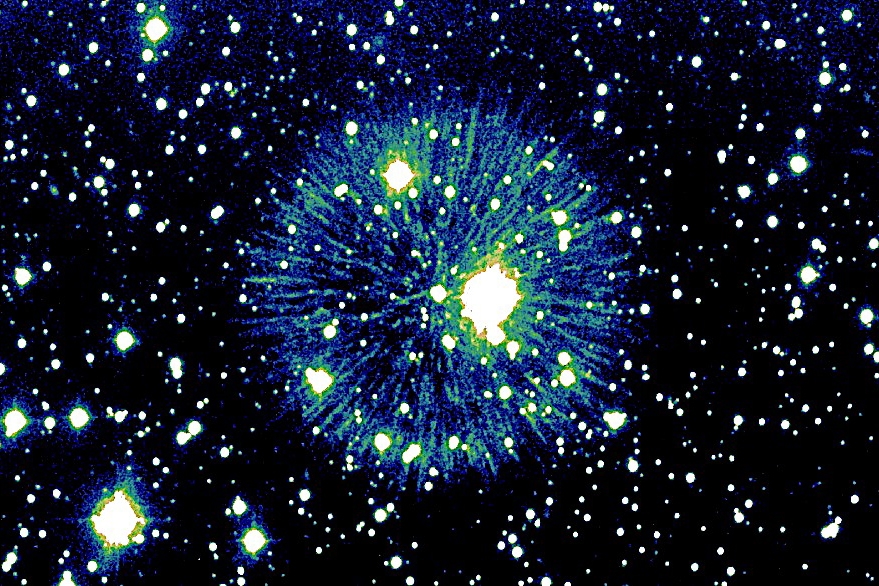From Steller Science,
BY: GOVERT SCHILLING ,
Edited by Amal Udawatta

Robert Fesen
A supernova explosion that skywatchers in the Far East observed almost 850 years ago has produced the most unusual remnant astronomers have ever found. “I’ve worked on supernovae for [decades], and I’ve never seen anything like this,” says Robert Fesen (Dartmouth College), who photographed the weird object in late October 2022 with the 2.4-meter Hiltner telescope at Kitt Peak.
Fesen presented his results at the 241st meeting of the American Astronomical Society (AAS) in Seattle; a paper has been submitted to Astrophysical Journal Letters (preprint available here). In other work presented at the AAS meeting and submitted to Monthly Notices of the Royal Astronomical Society (preprint here), his coauthor Bradley Schaefer (Louisiana State University) argues that the supernova resulted when two white dwarf stars collided, leaving an extremely energetic “zombie” star behind.
Amateur astronomer (and Fesen’s second coauthor) Dana Patchick discovered the nebula in August 2013 in archived images from NASA’s Widefield Infrared Survey Explorer (WISE). The infrared images didn’t show much detail, though. Originally, Patchick believed he had found a planetary nebula — his 30th find, hence the name Pa 30 — but later spectroscopic observations revealed that it’s more likely to be a supernova remnant. However, the nebula doesn’t produce many radio or X-ray waves, and there’s no neutron star or black hole in its center. Instead, the central star (sometimes known as Parker’s Star, after University of Hong Kong astronomer Quentin Parker who first studied its spectrum) turns out to be a peculiar white dwarf.
Still, astronomers are now confident about its relation with SN1181, a zero-magnitude supernova that appeared in northern Cassiopeia on August 6th of 1181 AD. Chinese and Japanese observers recorded this “guest star” slowly fading over a period of six months.
In the 1970s, astronomers speculated that supernova remnant 3C58 and the associated pulsar PSR J0205+6449 were the most likely remains of the 12th-century blast. However, says Schaefer, later research showed that 3C58 is much too old. Also, the sky position doesn’t match the Chinese observations. Pa 30 fits the bill on all accounts, according to a 2021 study by Andreas Ritter (University of Hong Kong), Parker, and their colleagues. In particular, the measured expansion velocity of the nebula — some 1,100 kilometers per second — puts its age at 850 years old.
Then again, says Schaefer, the central white dwarf star is “a whacko weird thing.” Its surface temperature is some 200,000 kelvin; it shines at 130 times the luminosity of the Sun, and it is fading quite rapidly, by 1.7 magnitudes over the past century. Most remarkably, it produces an unprecedentedly speedy stellar wind that travels outward at 16,000 kilometers per second, or 5% the speed of light.
“It’s insane,” Fesen says. “Stars simply don’t have 16,000 km/s winds. Even giant, luminous Wolf-Rayet stars have winds at a few thousand km/s at most.” So what peculiar kind of supernova might explain all this?
Fesen’s new observations of Pa 30, obtained in the light of ionized sulfur and revealing much more detail than infrared or visible-light broadband images, contain the last piece in the puzzle of SN1181. Despite the nebula’s distance of almost 8,000 light-years, the image shows intriguing radial filaments, presumably produced when the fierce stellar wind erodes away small clumps of lower-velocity gas ejected by the explosion. AAS media fellow Ben Cassese, who just happened to be in the control room of the telescope when the observations were carried out, vividly remembers Fesen’s excitement that night. “Even the raw data clearly showed the remarkable pattern,” he says.
According to the 2021 paper by Ritter and his colleagues, SN1181 was a low-luminosity supernova of the rare type Iax. While “normal” Type Ia supernovae result from the catastrophic detonation of a white dwarf star, in less luminous Type Iax supernovae the exploding star somehow survives.
Theorists have come up with various scenarios to explain Iax explosions. Some of these predict the existence of a matter-donating companion star; however in the case of Parker’s Star, detailed observations by NASA’s TESS observatory indicate that it’s single. According to Schaefer, only one model matches the observations of Pa 30 and its “whacko weird” central star: the collision of two white dwarfs, one of which consists mainly of carbon and oxygen and the other of oxygen and neon.
Jacco Vink (University of Amsterdam), an expert on supernova remnants who was not involved in these studies, agrees. “It’s great that they have identified a remnant” for SN1181, he says, “especially since it is from a type of supernova that is not yet completely understood.”
Future observations of the intriguing remnant and the “zombie star” at its core will shed more light on this rare and peculiar type of supernova explosion. Fesen has already applied for observing time on both the Hubble Space Telescope and the James Webb Space Telescope. “The JWST image will be simply amazing,” he says. “It would make for a great 4th of July image.”
Comments
Post a Comment